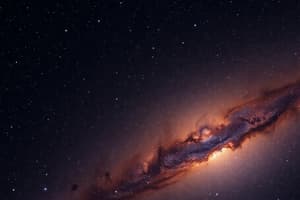Podcast
Questions and Answers
If two stars have the same apparent brightness, but Star A is farther away from Earth than Star B, what can be inferred about their absolute brightness?
If two stars have the same apparent brightness, but Star A is farther away from Earth than Star B, what can be inferred about their absolute brightness?
- Star A and Star B have the same absolute brightness.
- It is impossible to determine their relative absolute brightnesses without knowing their temperatures.
- Star A has a higher absolute brightness than Star B. (correct)
- Star A has a lower absolute brightness than Star B.
A star appears orange in the night sky. Based on this information, which of the following is the most likely range for its surface temperature, relative to other stars?
A star appears orange in the night sky. Based on this information, which of the following is the most likely range for its surface temperature, relative to other stars?
- Among the hottest stars.
- Hotter than red stars, but cooler than yellow stars. (correct)
- Hotter than blue stars.
- Among the coolest stars.
Which of the following statements best describes the relationship between a star's size, temperature, and brightness?
Which of the following statements best describes the relationship between a star's size, temperature, and brightness?
- Brightness is determined by both size and temperature; larger and hotter stars are generally brighter. (correct)
- Size and temperature have no impact on a star's brightness.
- Hotter stars are always brighter, regardless of size.
- Larger stars are always brighter, regardless of temperature.
Why do astronomers use both apparent and absolute brightness when studying stars?
Why do astronomers use both apparent and absolute brightness when studying stars?
Considering two stars of similar size, one appears blue and the other red when observed from Earth. What can be concluded about the stars' temperatures and brightness?
Considering two stars of similar size, one appears blue and the other red when observed from Earth. What can be concluded about the stars' temperatures and brightness?
Flashcards
Number of galaxies
Number of galaxies
There are about 170 million galaxies in the universe.
Time for sunlight
Time for sunlight
It takes 8 minutes and 20 seconds for sunlight to reach Earth.
Characteristics of a star
Characteristics of a star
Stars are defined by brightness, temperature, color, size, and mass.
Apparent vs Absolute brightness
Apparent vs Absolute brightness
Signup and view all the flashcards
Star color and temperature
Star color and temperature
Signup and view all the flashcards
Study Notes
Galaxies
- Approximately 170 million galaxies exist.
Stars
- Stars are luminous celestial bodies visible at night.
- Key characteristics include brightness, temperature, color, size, and mass.
Brightness
- Larger stars are brighter and hotter.
- Hotter stars shine more brightly than cooler ones.
- Apparent brightness is a star's visibility from Earth.
- Absolute brightness is a star's brightness if all stars were equidistant from Earth.
Color and Temperature
- A star's color directly relates to its temperature.
- The color spectrum, from coldest to hottest, is: Red, Orange, Yellow, White, Blue.
- Red stars are the coldest, while blue stars are the hottest.
Studying That Suits You
Use AI to generate personalized quizzes and flashcards to suit your learning preferences.




